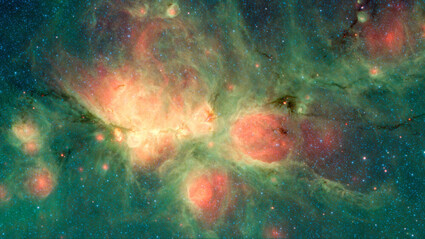Stars over Sisters
Last updated 6/20/2023 at 5:47pm

Photo Courtesy of NASA
The Cat's Paw Nebula is an emission nebula located 4,200 to 5,500 light years away in the constellation of Scorpius. Image from NASA's Spitzer Space Telescope.
As spring becomes summer, stargazers are eagerly anticipating the appearance of prominent constellations such as Cygnus, Hercules, and Sagittarius. However, one constellation stands out in the night sky - Scorpius the scorpion. This zodiac constellation can be seen from most parts of the world, resting between Libra and Sagittarius.
One of the most striking features of Scorpius is its distinct long, curving tail, which stretches across a significant portion of the sky and is composed of several bright stars, recognizable even to those unacquainted with the constellations. In June, it can be found as darkness falls in the southeastern sky just above the horizon.
The bright-red supergiant star Antares lies at the heart of Scorpius. Antares, meaning "rival of Mars," lives up to its name as one of the brightest stars in the night sky. Its distinct red coloration comes from its relatively low surface temperature, providing a captivating hue when observed from Earth.
Scorpius boasts an array of celestial objects that observers can see with a low-powered telescope, including multiple globular clusters, such as Messier 4, which contains hundreds of thousands of stars. The Cat's Paw Nebula, or NGC 6334, also resides in Scorpius. This emission nebula is a dramatic star-forming region.
Scorpius has held significance for numerous civilizations throughout history. In Greek mythology, Gaia the Earth sent the scorpion to slay Orion the hunter, who boasted he would kill all the beasts of the world. However, after the fatal sting, Orion killed the scorpion with a step of his foot. Orion and Scorpius were placed on opposite sides of the sky, perpetually chasing each other from view. As one rises, the other sets. Orion dominates the winter heavens, while Scorpius lights up the summer night sky.
Celestial enthusiasts have a lot to look forward to in June, starting with the full moon on June 3. Early Native American tribes referred to this full moon as the Strawberry Moon, symbolizing the time to gather the ripening fruit.
June 3 also brings another celestial treat: Venus at its greatest eastern elongation. Venus will reach its highest point above the horizon in the evening sky, attaining a staggering separation of 45.4 degrees from the Sun. Stargazers can spot the dazzling planet in the western sky shortly after sunset.
On June 17, the new moon arrives, when the moon is positioned on the same side of the earth as the sun. Consequently, the night sky will become devoid of moonlight, providing an ideal opportunity to observe faint objects such as galaxies and star clusters.
June 21 marks a significant astronomical event - the summer solstice. At 7:57 a.m. PDT, Earth's North Pole will tilt closest to the sun, signifying the first day of summer in the Northern Hemisphere. Simultaneously, the Southern Hemisphere will experience the first day of winter.
Finally, the June Boötid meteor shower will be active from June 22 to July 2, with its peak rate of meteors expected around June 27. During this period, the radiant point of the meteors is above the horizon in the constellation Boötes.
Our dark-sky tip for June is to ensure your outdoor lights are properly targeted and shielded so that the light is only shining on the intended area. This will help prevent light pollution and preserve the beauty of the night sky. By directing lights downward and using shielded fixtures, we can minimize the unnecessary escape of light. Let's take these simple steps to protect the wonders of the night sky for ourselves and future generations.
















Reader Comments(0)